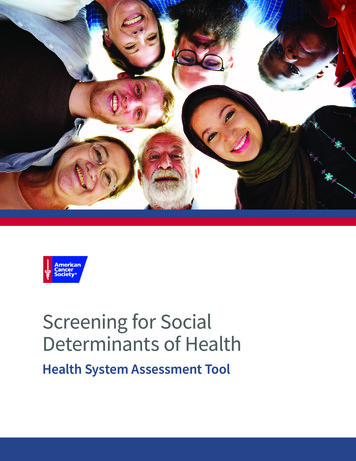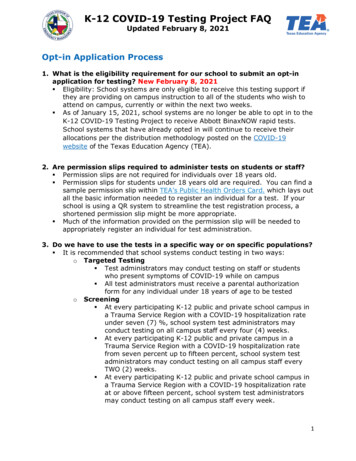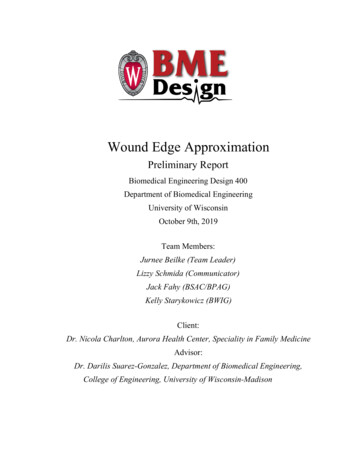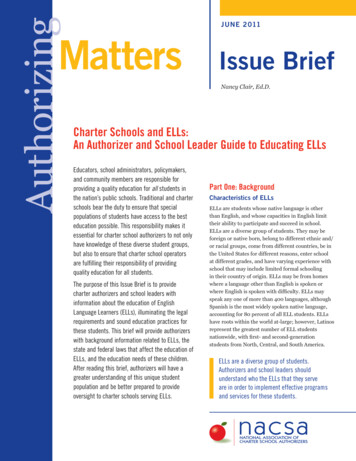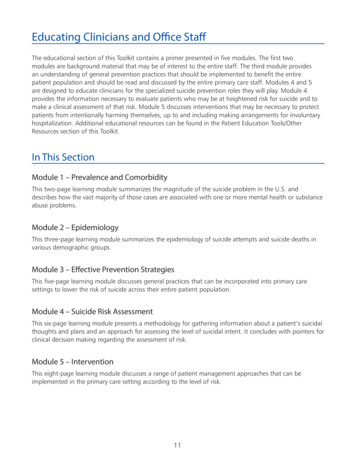
Transcription
Educating Clinicians and Office StaffThe educational section of this Toolkit contains a primer presented in five modules. The first twomodules are background material that may be of interest to the entire staff. The third module providesan understanding of general prevention practices that should be implemented to benefit the entirepatient population and should be read and discussed by the entire primary care staff. Modules 4 and 5are designed to educate clinicians for the specialized suicide prevention roles they will play. Module 4provides the information necessary to evaluate patients who may be at heightened risk for suicide and tomake a clinical assessment of that risk. Module 5 discusses interventions that may be necessary to protectpatients from intentionally harming themselves, up to and including making arrangements for involuntaryhospitalization. Additional educational resources can be found in the Patient Education Tools/OtherResources section of this Toolkit.In This SectionModule 1 – Prevalence and ComorbidityThis two-page learning module summarizes the magnitude of the suicide problem in the U.S. anddescribes how the vast majority of those cases are associated with one or more mental health or substanceabuse problems.Module 2 – EpidemiologyThis three-page learning module summarizes the epidemiology of suicide attempts and suicide deaths invarious demographic groups.Module 3 – Effective Prevention StrategiesThis five-page learning module discusses general practices that can be incorporated into primary caresettings to lower the risk of suicide across their entire patient population.Module 4 – Suicide Risk AssessmentThis six-page learning module presents a methodology for gathering information about a patient’s suicidalthoughts and plans and an approach for assessing the level of suicidal intent. It concludes with pointers forclinical decision making regarding the assessment of risk.Module 5 – InterventionThis eight-page learning module discusses a range of patient management approaches that can beimplemented in the primary care setting according to the level of risk.11
12
SPRCMental Health ProgramA GUIDE FOR PRIMARY CARE PROVIDERS AND MEDICAL PRAC TICE MANAGERS
14
List of ModulesPrimerPage #Module 1 – Prevalence and Comorbidity16Module 2 – Epidemiology18Module 3 – Effective Prevention Strategies21Module 4 – Suicide Risk Assessment26Warning Signs and Risk Factors26Protective Factors28Suicide Inquiry28Clinical Judgment of Suicide Risk3132Module 5 – InterventionPCP Treatment32Safety Planning33Referral to Evidence-Based Treatment38Documentation & Follow-up Care3915
Module 1 – Prevalence and ComorbidityPrevalence of SuicideMore than 44,000 U.S. individuals died by suicide in 2015.1From 1999 to 2015, the U.S. suicide rate increased by 27%.1U.S. Suicide RatesRates per 100,000 population252015105019992015Suicide impacts people of all ages in the U.S.2: Suicide is the tenth leading cause of death in the U.S. Suicide is the third leading cause of death for children ages 10-14 and the second leading cause ofdeath for children ages 15-34.In 2015, 9.8 million U.S. adults (4.0%) considered suicide in the past year, of those approximately, 28%(2.7 million) made a suicide plan, and 14% (1.4 million) attempted suicide.3 Some of these people willseek your care.Rates of suicidal behaviors and death by suicide are higher in rural areas.4In Primary Care:Individuals often use health services prior to death by suicide.83% of individuals who died by suicide had a health care visit in the year prior to their death andcontact with a primary care provider (PCP) was the most common visit type (64%).5ComorbidityMental illness is neither a necessary nor sufficient condition for suicide, but is strongly associatedwith suicide.Adults with a mental illness are at increased risk for attempting and completing suicide, and thosewith multiple (comorbid) disorders have at least a two-fold risk of suicide attempts, increasing with thenumber of comorbid disorders.6,716
Approximately 66% of adults who consider suicide and nearly 80% of those who attempt suicidehad a prior mental health disorder.6 More than 70% of adults who have attempted suicide have an anxiety disorder.7 Adults with mood, anxiety, or substance use disorders have been shown to be at greater risk ofcontemplating or attempting suicide.6,8Adults who had a Substance Use Disorder (SUD) or Major Depressive Episode (MDE) within the past yearare significantly more likely to have suicidal thoughts, make suicide plans, and attempt suicide.3Adults who use alcohol or drugs are more likely to have suicidal thoughts, make suicide plans, andattempt suicide.3Past Year Suicide Attempts Among Adults 18 or Older – 2015 NSDUH5%4.2%4%3%2.2%2%1%1.7%0.6%0.6%0%All adultsPast YearSUDPast YearMDEPast YearPast Year IllicitAlcohol UseDrug UseSimilar patterns have been found for youth, with mood disorders being strongly associated with suicidalthoughts, plans, and attempts. Substance use, anxiety, and disruptive behavior disorders are associatedwith suicidal thoughts and attempts, and eating disorders are associated with suicide attempts.9Proactive support and treatment of psychiatric and substance use disorders is an important part of acomprehensive, primary-care based approach to suicide prevention.17
Module 2 – EpidemiologyHigh Risk PopulationsAll demographic groups have some level of risk. It is important not to dismiss any individual as being freeof risk because they belong to a particular demographic group. There are some demographic groups,however, that are at relatively greater risk than others. See Module Four, Suicide Risk Assessment, for information on individual, social/environmental, andsocietal risk factors.GenderMales are about three times more likely to die by suicide than females.1 However, the U.S. rates for femaleshave increased by approximately 50% since 1999.10 Therefore, both should be supported with suicidepreventative care.AgeWhile adolescents and young adults are more likely to consider suicide, adults have higher rates ofdeath by suicide.11,12Adults aged 18-25 are more likely to consider suicide, plan for suicide, and attempt suicide than adultsaged 26 or older.3 Yet adults 45 years or older, especially men, have the highest suicide rates.11For children and adolescents, the death rate for suicide doubled from 2007 (0.9) to 2014 (2.1).13From 2011 to 2015, reported rates of considering suicide, planning for suicide, and attempting suicide forhigh school youth have slightly increased.12High school females have higher reported rates of making a suicide plan and attempting suicide than highschool males.12Rates for Planning For and Attempting Suicide for U.S. High School Youth20%15%U.S. suicide plans10%U.S. suicide attempts5%0%20112013182015
Race/EthnicityPatterns of suicide rates emerge among the various races, with American Indians and Alaska Nativeshaving high suicide rates.In 2015, the U.S. suicide rate was highest for American Indians and Alaska Natives, followed by Whiteindividuals, Asian and Pacific Islander individuals, Black individuals, and Hispanic individuals.1For American Indian and Alaska Native adolescents and young adults ages 15-34, the suicide rate isespecially high, 1.5 times that of the national average.14In 2015 multi-racial high school students had the highest reported rates of planning for and attemptingsuicide, followed by American Indian or Alaska Native students.12Note: White, Asian and Pacific Islander, and Black individuals’ statistics reported are non-Hispanic.Lesbian, Gay, Bisexual, Transgender, Queer IndividualsThese groups have disproportionately high rates of reported suicideattempts.15Overall, lesbian, gay, and bisexual (LGB) individuals are more thantwice as likely as heterosexual persons to attempt suicide.15 Thiscommunity is also more likely to be at risk for depression, anxietydisorders, and substance dependence.15,16 Potential reasons forthese elevated rates include the prejudice, discrimination, andsocial stigma faced by these groups.17Rates of reported attempted suicide for LGB youth have beenshown to range from 20% to 53%, and in one small focusedstudy, transgender youth had a 25% lifetime rate of attemptedsuicide.18,19 Parental support or rejection also appears to play asignificant role, as LGB young adults who reported high levels ofrejection by their families were 8.4 times more likely to report having attempted suicide.16VeteransVeterans of the armed forces carry an alarmingly and disproportionately higher risk for suicide than thecivilian population, and are often not utilizing the Veterans Health Administration (VHA) for their healthcare.It is always helpful for practices to ascertain Veteran status, as they are likely to see Veterans who may notknow that they are entitled to services from the VHA,and knowing Veteran status provides indications ofthe need for other screenings, such as trauma andtraumatic brain injury.On average, 20 U.S. Veterans die by suicide eachday.20 Veterans’ risk of suicide is 21% higher thanthat of U.S. adult civilians and, while Veterans madeup 8.5% of the U.S. adult population in 2014, theyaccounted for 18% of suicide deaths.20 Male Veteranshave an 18% higher suicide risk than U.S. civiliansand female Veterans’ risk is twice as high as U.S.civilians. More than half of all Veterans who die bysuicide are age 50 or older.2019
Only 28% of Veterans receive at least one healthcare service or benefit from the VHA.21 From 2001 to2014, the suicide rate for Veterans has increased at a much greater rate than U.S. civilians, and Veteranswho did not receive services from the VHA had a greater increase than Veterans who used VHA services;however, the difference between suicide rates for Veterans who did not receive VHA services and thosewho did has decreased since 2001.20Veterans who die by suicide are more likely to use a firearm. Approximately two-thirds of Veterans thatdied by suicide used a firearm, while about half of U.S. adults aged 17 and older used a firearm in theirsuicide.20,1About 24% of all U.S. Veterans reside in rural communities, which may be far from military or Veteransservices.2220
Module 3 – Effective Prevention StrategiesPrimary care providers can implement some of the most effective strategies for suicide prevention. Ideally,a primary care clinic would plan a comprehensive suicide prevention approach such as the Zero Suicideframework (see information on Zero Suicide in Section 6: Patients Education Tools/Other Resources ofthis Toolkit) that includes all the strategies in the box below. We will discuss the strategies in five sections:staff training, screening and management of depression, screening for suicide risk, patient education, andrestricting means for lethal self-harm. Assessing and managing patients at risk for suicide are discussed inModules 4 and 5 of this Primer.Suicide Prevention Strategies in Primary Care1. Train staff to recognize and respond to warning signs of suicide2. Screen for and manage depression3. Screen all patients for suicide risk4. Educate patients about warning signs for suicide5. Safety Plan/Temporarily restrict means for lethal self-harm1. Train Staff to Recognize Warning Signs of SuicideAs workers in primary care settings interact with their patients, they may able to observe andrespond to many of the common warning signs for suicide, but only if they know what to look for.All staff should be trained in suicide prevention, relative to their role in the clinic. In addition to theinformation provided below, suicide prevention trainings or individual online learning can teachrecognition and response to suicide warning signs. Trainers are available in most areas to teach theseimportant skills. Training is also available online. See the Resource List for some of the national vendorsof these programs; contact the authors or the Suicide Prevention Resource Center (www.sprc.org/states) for your state’s suicide prevention coordinator. After even minimal training, staff can observe andrespond to warning signs of suicide in patients while talking with them on the phone or in the office.When they detect a warning sign, staff can immediately alert office clinicians who are prepared to askthe patient about suicidal ideation. Though these trainings require a modest investment of time andmoney, they may save lives.Identify Warning SignsPeople who are in danger of harming themselves may reach out to their primary care providers –sometimes directly, sometimes indirectly. Rarely will patients immediately volunteer the informationthat they are thinking of harming themselves or ending their lives. Be alert for warning signs that apatient may be at risk of imminent suicide. Warning signs include:2321
Strongest Warning Signs – Take Immediate Action to Protect Person – Full Risk AssessmentWarranted Threatening to hurt or kill him/herself, or talking of wanting to hurt or kill him/herself Looking for ways to kill him/herself by seeking access to firearms, available pills, or other means Talking about feeling hopeless or having no reason to liveOther warning signs of suicide Anxiety Agitation, aggression Acting reckless Insomnia or sleep disturbance Increased alcohol or drug use Withdrawing or feeling isolated Talking about being a burden to others Rage or seeking revenge Dramatic mood swings Feeling trapped – like there’s no way out Talking about being in unbearable pain2. Screen For and Manage DepressionTraining providers to recognize and treat depression increases prescription rates forantidepressants and decreases suicidal ideation and completed suicides in their patients.24A key factor in reducing suicides and suicidal behaviors is the effective diagnosis and management ofmajor depression. Tools for screening and managing depression within a primary care setting have beendeveloped by The MacArthur Initiative on Depression and Primary Care and are available free of chargeonline. A downloadable toolkit can be found at: dfKeep in mind that the best approach to treating major depressive disorder (as well as many other mentalillnesses) uses a combination of medication and psychotherapy whenever possible.25,26,27 This is whyit is so important to have reliable and trusted mental health treatment partners to refer to.3. Screen all patients for Suicide RiskScreening all patients for suicidal thinking is an important part of suicide prevention and isrecommended by The Joint Commission.28 Patients with warning signs or other risk factors shouldroutinely be asked about suicidal thoughts as well. It is also helpful for practices to ascertain Veteranstatus, as they are likely to see Veterans who may not know that they are entitled to services from theVHA, and knowing Veteran status provides indications of the need for other screenings, such as traumaand traumatic brain injury.Using simple screening tools such as the 9-item Depression Scale of the Patient Health Questionnaire(PHQ-9) can be an effective, matter-of-fact, and time-efficient way to screen patients. PHQ-9 is includedas part of the MacArthur Initiative Toolkit discussed above and English and Spanish versions, as well asa modified version for adolescents are available at: e/screening-tools22
The Columbia Suicide Severity Rating Scale (C-SSRS) is another, more specialized tool for assessingsuicidality. If screening tools such as the PHQ-9 are used, providers must be diligent about reviewingpatient responses and specifically monitoring whether patients endorse items related to suicidality. TheC-SSRS is available at: http://cssrs.columbia.edu/Suicidal ideation can vary greatly. Some experience chronic suicidal ideation over the course of theirlifetime, some have thoughts of suicide in situations of acute stress, trauma, or loss. It is important tofully understand the context of someone’s thoughts of suicide and how it may impact their safety in theimmediate future by doing a complete assessment as laid out in Module 4 of this Primer.The Joint Commission Sentinel Event Alert (SEA) Number 56, Detecting and Treating SuicideIdeation in All Settings, outlines 8 guidelines for effectively addressing suicidal ideation in all caresettings, including the recommendation that providers “Screen all patients for suicide ideationusing a brief, standardized, evidence-based screening tool.” All SEA 56 recommendations can befound at: https://www.jointcommission.org/sea issue 56/Some or all of the Sample Questions in Module 4 for inquiring about thoughts of suicide can be usedfor informal screening of patients. The key is to ask directly about thoughts of suicide or endingone’s life as part of the screening. Practice asking the question(s) several times before trying it in aclinical situation.Never ask leading questions such as “You’re not thinking of hurting or killing yourself,are you?”Sample screening question:“We ask every one of our patients about whether they have felt suicidal or have been consideringhurting themselves. Have you had thoughts of hurting yourself or killing yourself?”“Sometimes people with your condition (or in your situation) feel like they don’t want to liveanymore, or sometimes they think about killing themselves. Have you been having any thoughts likethese?”A positive response to this screening question requires additional assessment (assessments can be foundin Module 4). These instruments should always be used as an augment to a thorough clinical interview.In addition to routine screening for all patients, certain conditions, situations or life events may warrantinquiry into whether the patient is experiencing suicidal thoughts, these RISK FACTORS include:Key Risk Factors29 Prior suicide attempt(s) History of depression or other mental Illness Alcohol or drug abuse Family history of suicide or violence Exposure to suicide in community, social circles, or themedia Physical illness or recent serious diagnosis23
Feeling alone Irritability, agitation, aggressionOther Risk Factors Other mental health or emotional problems Chronic pain Insomnia Post-Traumatic Stress Disorder (PTSD) Traumatic Brain Injury (TBI) Events or recent losses leading to humiliation, shame or despairThis Decision Support Tool, from the Suicide Prevention Resource Center’s Caring for Patients withSuicide Risk: A Consensus Guide for Emergency Departments, may be a helpful tool to screen forsuicide risk:30TRANSITION QUESTION: CONFIRM SUICIDAL IDEATION Have you had recent thoughts ofkilling yourself? Is there other evidence of suicidal thoughts, such as reports from family orfriends? (NOTE: the transitional question above is not part of scoring.)1. THOUGHTS OF CARRYING OUT A PLAN Recently, have you been thinking about how youmight kill yourself? If yes, consider the immediate safety needs of the patient.2. SUICIDE INTENT Do you have any intention of killing yourself?3. PAST SUICIDE ATTEMPT Have you ever tried to kill yourself?4. SIGNIFICANT MENTAL HEALTH CONDITION Have you had treatment for mental healthproblems? Do you have a mental health issue that affects your ability to do things in life?5. SUBSTANCE USE DISORDER Have you had four or more (female) or five or more (male)drinks on one occasion in the past month or have you used drugs or medication for nonmedical reasons in the past month? Has drinking or drug use been a problem for you?6. IRRITABILITY/AGITATION/AGGRESSION Recently, have you been feeling very anxious oragitated? Have you been having conflicts or getting into fights? Is there direct evidence ofirritability, agitation, or aggression?Scoring: Score 1 point for each of the Yes responses on questions 1-6. If the answer to theTransition Question and any of the other six items is “Yes,” further intervention, includingassessment by a mental health professional, is needed.4. Educate patients and their loved ones about Suicide Warning SignsJust as we educate the public on the warning signs of strokes and heart attacks, we should providebasic information to the public on the warning signs of suicide. For severe suicide warning signs, theappropriate response may be to call 911 or help the patient get to the nearest hospital emergencydepartment or acute crisis unit.24
For less emergent situations, it may be appropriate to call the National Suicide Prevention Lifeline,1-800-273-TALK (8255). Calls to this number are routed to a nearby certified crisis center with trainedcounselors. Counselors are available 24/7 and provide services in English, Spanish and many otherlanguages. Veterans calling the National Lifeline may press “1” to be directed to a crisis center run bythe Department of Veterans Affairs. The service is free anywhere in the United States. The most effectiveand expedient response will depend on the resources in your area.This Toolkit contains a wallet card (pg 66) for everyone that list the most recognizable warning signs andthe number of the national crisis line. These cards are available free and can be provided to all primarycare patients and their loved ones through the office. For information on ordering the wallet cards, seethe SAMHSA Store or the “National Suicide Prevention Lifeline Resources” web address in the ResourceList of the Toolkit.5. Safety Plan and Temporarily Restrict Means of Lethal Self-HarmAs primary care providers, you and your staff can and should work with suicidal or potentiallysuicidal patients and their loved ones to temporarily restrict means of lethal self-harm in theirhomes. Involuntary commitment and hospitalization should be utilized only as last resorts, whensafety planning has been unsuccessful and the patient is assessed to be at imminent risk of harmingthemselves.Safety Planning: A safety plan (also referred to as a “crisis response plan”) is developed collaborativelywith the patient and is designed to decrease the probability that the patient will attempt suicide in thenear future. A simple and structured safety planning process is reviewed in detail in Primer Module5: Intervention.31Temporarily Restricting Means of Lethal Self Harm: This step can be the hardest step for manypatients, and perhaps the most critical. The stronger the collaboration between the provider and thepatient, the greater the likelihood the patient will agree to solutions to temporarily restrict his or heraccess to lethal means. Lethal means restriction for patients of all ages is reviewed in detail inPrimer Module 5: Intervention.25
Module 4 – Suicide Risk AssessmentWhile there is no way to predict with complete certainty who will attempt suicide, understanding certainimminent warning signs as well as statistically related risk factors will help providers know when to activelyintervene and further assess for imminent suicide risk.Key components of a suicide risk assessment32,331. Assess warning signs and risk factors2. Assess protective factors3. Suicide Inquiry: thoughts/plan/intent/access to means4. Clinical judgment1. Warning Signs and Risk FactorsWarning signs are changes in behavior or new behaviors that may indicate that a person issuicidal, while risk factors are characteristics or conditions that increase the chance that a personmay try to take their life.Identify Warning SignsPeople who are in danger of harming themselves may reach out to their primary care providers–sometimes directly, sometimes indirectly. Rarely will patients immediately volunteer the informationthat they are thinking of harming themselves or ending their lives. Be alert for warning signs that apatient may be at risk of imminent suicide. Warning signs include:23Strongest Warning Signs – Take Immediate Action to Protect Person – Full Risk AssessmentWarranted Threatening to hurt or kill him/herself, or talking of wanting to hurt or kill him/herself This includes statements such as: “My family would be better off without me”; “I won’t be aroundfor xxx” Among the elderly, these statements may sound more like “I don’t want to be a burden” or “Idon’t belong anywhere anymore” Looking for ways to kill him/herself by seeking access to firearms, available pills, or other means Talking or writing about death, dying or suicide, when these actions are out of the ordinary for thepersonOther warning signs of suicide Anxiety, agitation, irritability Insomnia or sleep disturbance Increased alcohol or drug use Purposelessness – no reason for living Hopelessness26
Withdrawing from friends, family and society Rage, uncontrolled anger, seeking revenge Acting reckless or engaging in risky activities, seemingly without thinking Dramatic mood changes Feeling trapped – like there’s no way outSuicidal behavior is associated with many different types of events, illnesses, and life circumstances.34The strongest predictor of suicide is one or more previous attempts; however, most people whodie by suicide die on their first attempt. A prior suicide attempt does not always mean that a personwill go on to complete suicide; over 90% of individuals who have survived an attempt will not go on tolater die by suicide. It is important to take all attempts seriously, however, and not interpret a patientwho has had multiple attempts as solely “attention seeking.” Help, hope, and recovery are possible.35There are many factors that increase risk for suicide. A greater number of identified risk factors issuggestive of greater risk.36Individual Risk Factors Previous suicide attempt, especially within the past year Major physical illnesses, especially with chronic pain Central nervous system disorders, including TBI Mental illnesses, particularly: Mood disorders Schizophrenia Anxiety disorders (including, PTSD) Certain alcohol and other substance use disorders Personality disorders (such as Borderline PD, Antisocial PD, and Obsessive-Compulsive PD) In youths: Attention-deficit/hyperactivity disorder (ADHD) and conduct disorders (antisocialbehavior, aggression, impulsivity) Psychiatric symptoms/states of mind: anhedonia (diminished or inability to gain pleasure fromnormally pleasurable experiences or activities), severe anxiety/panic, insomnia, commandhallucinations, intoxication, self-hate Impulsive and/or aggressive behavior History of trauma or abuse Family history of suicide or exposure to suicide in social network, community, media Precipitants/triggering events leading to humiliation, shame, or despair (e.g., loss of relationship,health or financial status – real or anticipated)Social/Environmental Risk Factors Chaotic family history (e.g., separation or divorce, change in caretaker, change in living situation orresidence, incarcerations) Lack of social support and increasing sense of isolation Easy access to/familiarity with lethal means (e.g., guns, illicit drugs, medications) Local clusters of suicide that can have a contagious influence27
Legal difficulties/contact with law enforcement/incarceration Barriers to accessing health care, especially mental health and substance abuse treatmentSocietal Risk Factors Certain cultural and religious beliefs (for instance, the belief that suicide is a noble resolution of apersonal dilemma)36 Exposure to, including through the media, and influence of others who have died by suicide2. Protective FactorsWhile protective factors provide only a limitedcounterbalance to individuals who are high-riskfor attempting suicide (i.e., someone with strongideation, intent, a plan, preparatory behaviors,and impaired judgment) and vary greatly fromone individual to another, protective factors maymitigate risk in a person with moderate to lowsuicide risk. Strengthening protective factors can bea part of safety planning, which will be discussed inModule 5.Some important protective factors are:37 Sense of responsibility to family Life satisfaction Social support; belongingness Coping skills Problem-solving skills Strong therapeutic relationship with a trusted provider Reality testing ability Religious faith3. Suicide InquiryIf any suicide warning signs are evident or if significant risk factors are present, an initial suicideinquiry is warranted. Patients will generally not spontaneously report suicidal ideation, but 70%communicate their intentions or wish to die to significant others. Ask patients directly about suicide andseek collateral information from other clinicians, family members, friends, EMS personnel, police, andothers.38Asking about suicide and suicidal thoughts can be very uncomfortable for some providers – it is importantfor providers to assess their own level of comfort with suicide inquiry and rehearse or role-pay to increasetheir level of comfort. Read on for a variety of tools and sample questions that you can use to assesssuicide risk. How you ask the questions affects the likelihood of getting a truthful response. Use a nonjudgmental, non-condescending, matter-of-fact approach.28
NEVER ask leading questions like:“You’re not thinking of suicide, are you?”“I hope that you aren’t thinking about hurting yourself.”PRACTICE the questions below several times prior to a clinical encounter; again, asking about suicidefor the first time may be harder than you think!Thoughts of SuicideAsk patients you suspect may be feeling suicidal about thoughts or feelings related to suicide. The samplequestions below will help you ease into the subject in a non-threatening way.Questions to uncover suicidal thinking:39“Sometimes, people in your situation (describe the situation) lose hope; I’m wondering if you mayhave lost hope, too?”“Have you ever thought things would be better if you were dead?”“With this much stress (or hopelessness) in your life, have you thought of hurting yourself?”“Have you ever thought about killing yourself?”Prior AttemptsA history of a prior attempt is the strongest predictor of future suicidal behavior.
More than 44,000 U.S. individuals died by suicide in 2015.1 From 1999 to 2015, the U.S. suicide rate increased by 27%.1 U.S. Suicide Rates Suicide impacts people of all ages in the U.S.2: Suicide is the tenth leading cause of death in the U.S. Suicide is the third leading cause of death for children ages 10-14 and the second leading .


